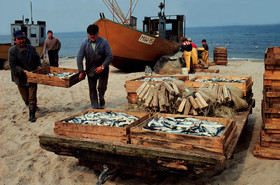Common Fisheries Policy, CFP

- (Photo: Commission)
Fish are seen as an agricultural product, and therefore governed by the treaty articles on agriculture. The EU has a Common Fisheries Policy (CFP). In order that the coastal waters of the EU are not over-fished, fishing quotas are allocated to Member States. The EU decides the Total Allowance Catch (TACs) by a qualified majority vote in the Council. The decisions reached often ignore the amount of fishing that scientists advise is necessary in order to sustain fish stocks. The EU also decides, by qualified majority vote, what amount of fish can be caught by each nation.
The final rules made by the Council of Ministers usually allow more fishing than is recommended by the biological council.
Notes
In 2002, the EU Commission proposed a new CFP. Spain disagreed with this and the Spanish Prime Minister, Jose Maria Aznar, asked the Commission President, Romano Prodi, to sack the fisheries Director General, Steffen Smidt. He succeeded and Smidt was removed from office.By December 2002, a new version of the CFP was produced with which Spain agreed.
The future
The EU Constitution proposes that the conservation of marine biological resources must be under the control of only the EU (an exclusive EU competence), and that general fishing policy become a shared competence - EU law would therefore suppress member states' existing legislation and right to legislate in this area.Links
http://www.europarl.eu.int/factsheets/4_2_1_en.htm
http://www.europarl.eu.int/factsheets/4_2_2_en.htm
http://www.europarl.eu.int/factsheets/4_2_3_en.htm
http://www.europa.eu.int/comm/fisheries/reform/index_en.htm
